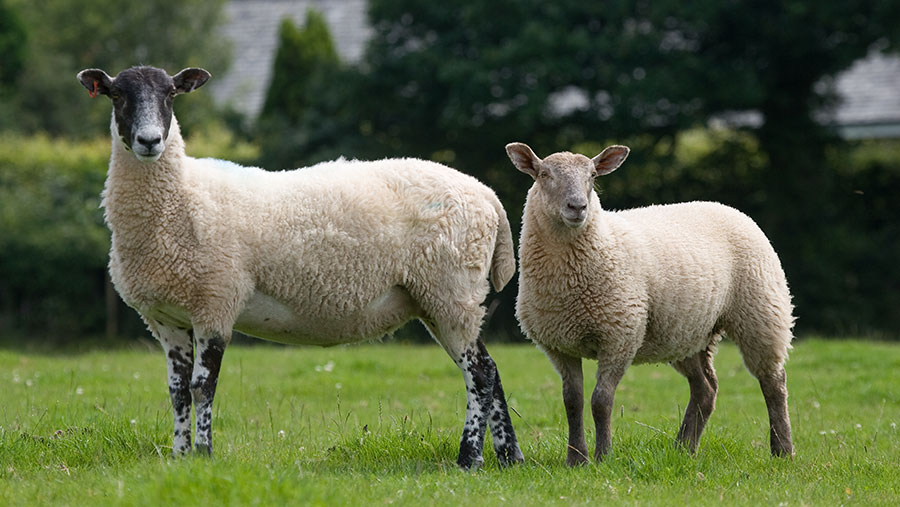Shortages of key vaccines threaten flock health
 © Tim Scrivener
© Tim Scrivener Shepherds are currently facing supply shortages of the vaccines Heptavac P Plus and Footvax.
Manufacturer MSD Animal Health said stock disruption was being caused by “logistics and regulatory challenges in 2021 due to Brexit that reduced safety stocks”.
Heptavac P Plus is the only vaccine on the market that is suitable for breeding ewes. It offers protection against pasteurellosis and clostridial disease, while Footvax helps prevent the contagious hoof infection foot-rot.
News of insufficient supplies follows a decision on 24 May by the National Office of Animal Health (Noah) to change the status to category one or highest priority of five key sheep vaccinations, including clostridial disease, foot-rot and pasteurellosis.
This status means flocks should consider these vaccinations as a default.
See also: Pasteurella vaccines: Common mistakes and how to avoid them
The National Sheep Association (NSA) has written to Noah voicing its concern.
Advice
In a statement, MSD Animal Health said stocks were likely to remain tight until early summer, but it would not be any more specific on dates.
Speaking to Farmers Weekly, sheep vet Fiona Lovatt of Flock Health said the situation could make flock health more challenging this season and next.
“Not being able to access vaccine is a nightmare for shepherds. Vaccines are such an important tool, but by no means the only thing farmers can do,” she said.
“It makes it much more challenging if we don’t have access to vaccines, but farmers will have to more careful with everything else, such as reducing stress and managing food and pasture changes to minimise the risk of pasteurellosis and clostridial disease.
“It’s a critical time to be working closely with your vet,” she advised.
The immediate shortage in supply will be particularly unhelpful for farmers who want to vaccinate future breeding ewes against foot-rot and clostridial disease now, added Dr Lovatt. This is typically done at weaning, which is currently happening on many farms, or before tupping.
“In terms of lameness control, the vaccine is extremely helpful and, even if vaccination is delayed, it is still very much worth doing. If farmers can’t immediately get hold of vaccine, they have to make sure they are doing every other part of the five-point plan very rigorously,” she said.
The five-point plan provides a clear strategy to control lameness on farm.
If shepherds are unable to source Heptavac P Plus, Ovipast P can be used instead alongside either Bravoxin or Covexin (see “Suitability of different vaccines for a range of diseases”), advised Dr Lovatt.
MSD Animal Health said it was working closely with its global supply chains, distributors and prescribers to minimise product disruption, and recommended farmers speak to their vet or suitably qualified person for further guidance if they had concerns about vaccination plans.
A spokesperson for the pharmaceutical company advised farmers to plan ahead as much as possible and make use of all available pack sizes to obtain the number of doses they required.
Advice on dealing with different scenarios
1. I cannot get hold of vaccine for flock replacements
Speak to your vet or suitably qualified person (SQP) as it will depend on what you need to cover (see table below). Any sheep that are kept and used for breeding in subsequent years will need a full primary course of Heptavac P Plus in pregnancy, if they have not already received one.
Suitability of different vaccines for a range of diseases |
|||||||||||
|
|
Struck |
Pulpy kidney |
Braxy |
Blackleg, metritis |
Black disease |
Bacterial redwater infection |
Tetanus |
Lamb dysentery |
Abomasitis, toxaemia, malignant oedema, metritis |
Enterotoxaemia |
Pasteurellosis |
|
Bravoxin |
✔ |
✔ |
✔ |
✔ |
✔ |
✔ |
✔ |
✔ |
✔ |
✔ |
|
|
Heptavac-P plus |
✔ |
✔ |
✔ |
✔ |
✔ |
|
✔ |
✔ |
|
|
✔ |
|
Ovivac-P plus |
|
✔ |
✔ |
✔ |
|
|
✔ |
|
|
|
✔ |
|
Ovipast plus |
|
|
|
|
|
|
|
|
|
|
✔ |
|
Covexin 8 |
✔ |
✔ |
✔ |
✔ |
✔ |
✔ |
✔ |
✔ |
|
|
|
|
Covexin 10 |
✔ |
✔ |
✔ |
✔ |
✔ |
✔ |
✔ |
✔ |
✔ |
✔ |
|
|
Source: MSD Animal Health and Fiona Lovatt |
|||||||||||
2. Booster not given in time to ewes
Two doses are required four to six weeks apart, with the second given four to six weeks before lambing.
If the booster is given later than this, the product will protect the ewe but will provide unknown protection to the lamb via colostrum.
Maintain excellent hygiene at lambing to reduce disease risk.
3. I cannot get enough doses
Prioritise future breeding ewes and rams, particularly first-time mothers, or speak to your vet about using Ovipast P alongside either Bravoxin or Covexin.
Do not:
- Use half doses to make vaccine go further
- Miss the second dose.
Both these strategies will leave animals unprotected.
